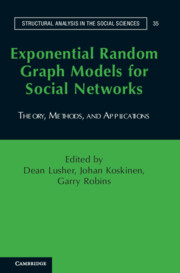Book contents
- Frontmatter
- Contents
- List of Figures
- List of Tables
- 1 Introduction
- Section I Rationale
- Section II Methods
- Section III Applications
- 14 Personal Attitudes, Perceived Attitudes, and Social Structures: A Social Selection Model
- 15 How To Close a Hole: Exploring Alternative Closure Mechanisms in Interorganizational Networks
- 16 Interdependencies between Working Relations: Multivariate ERGMs for Advice and Satisfaction
- 17 Brain, Brawn, or Optimism? Structure and Correlates of Emergent Military Leadership
- 18 Autologistic Actor Attribute Model Analysis of Unemployment: Dual Importance of Who You Know and Where You Live
- 19 Longitudinal Changes in Face-to-Face and Text Message–Mediated Friendship Networks
- Chapter 20 Differential Impact of Directors’ Social and Financial Capital on Corporate Interlock Formation
- 21 Comparing Networks: Structural Correspondence between Behavioral and Recall Networks
- Section IV Future
- References
- Index
- Name Index
19 - Longitudinal Changes in Face-to-Face and Text Message–Mediated Friendship Networks
Published online by Cambridge University Press: 05 April 2013
- Frontmatter
- Contents
- List of Figures
- List of Tables
- 1 Introduction
- Section I Rationale
- Section II Methods
- Section III Applications
- 14 Personal Attitudes, Perceived Attitudes, and Social Structures: A Social Selection Model
- 15 How To Close a Hole: Exploring Alternative Closure Mechanisms in Interorganizational Networks
- 16 Interdependencies between Working Relations: Multivariate ERGMs for Advice and Satisfaction
- 17 Brain, Brawn, or Optimism? Structure and Correlates of Emergent Military Leadership
- 18 Autologistic Actor Attribute Model Analysis of Unemployment: Dual Importance of Who You Know and Where You Live
- 19 Longitudinal Changes in Face-to-Face and Text Message–Mediated Friendship Networks
- Chapter 20 Differential Impact of Directors’ Social and Financial Capital on Corporate Interlock Formation
- 21 Comparing Networks: Structural Correspondence between Behavioral and Recall Networks
- Section IV Future
- References
- Index
- Name Index
Summary
Evolution of Friendship Networks, Communication Media, and Psychological Dispositions
Social relationships change over time. Within a social gathering, people form and maintain interpersonal relationships in several ways, whereas some relationships decline and others lapse after a certain period of time. The underlying processes of such relationship formation, maintenance, and dissolution can be differentiated in terms of purely structural network effects (see Chapter 3) and actor-relation effects (i.e., “social selection,” see Chapter 8; also see de Klepper et al., 2010; Robins, Elliott, & Pattison, 2001). To test how purely structural and social selection processes promote network formation respectively, this chapter examines the development of friendship networks expressed through face-to-face communication and mobile phone text messages among first-year undergraduates through an academic year.
Making friends at a university is one of the central concerns of first-year undergraduates. Friendship plays an important role in adaptation to novel social environments, especially during a major life transition such as university enrollment. Previous research has investigated the relationship between friendship network development among first-year undergraduates and its impact on adaptation to university (Hays & Oxley, 1986; Newcomb, 1961; van Duijn et al., 2003). However, the impact of different types of communication media on network formation and maintenance has not been fully studied. This chapter introduces patterns of longitudinal changes in interpersonal relationships and characteristics of communication media, especially text messages, in relation to strength of friendship ties. The effects of individual factors such as gender and social identity on the evolution of friendship network structure are also elaborated.
- Type
- Chapter
- Information
- Exponential Random Graph Models for Social NetworksTheory, Methods, and Applications, pp. 248 - 259Publisher: Cambridge University PressPrint publication year: 2012
- 1
- Cited by



